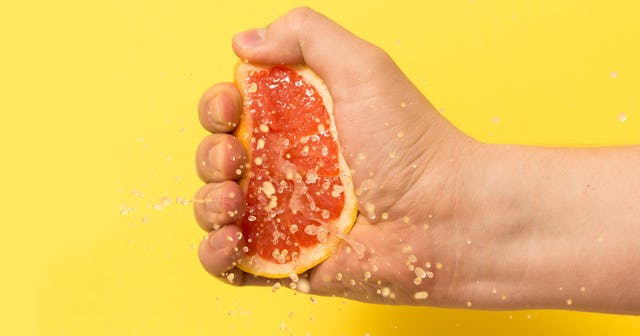Let’s Set The Record Straight On Squirting

The first time I’d ever heard someone talk candidly about squirting was when I saw “The Vagina Monologues.” A woman got up on stage and talked about the first orgasm she’d ever had, which was with a partner. As she spoke, she threw her body into the scene, and you could see talking about it made her upset.
She explained there was fluid “gushing and gushing out of her body” and it actually scared her because she didn’t know what it was.
Neither did her partner. He ended up getting up, leaving, and proceeded to tell everyone in school she peed herself.
For years, she didn’t understand what had happened — and was so upset by it, she didn’t orgasm for another five years.
You may have seen squirting in a porno, or perhaps it happens to you. Nonetheless, we can’t deny there is a lot of confusion when it comes to squirting and female ejaculation. Whether it happens to you or not, there isn’t a lot of conversation or dialogue around it, which may cause us to clam up, ignore it, or just remain confused by it.
The biggest misconception about female ejaculation and squirting is that they are the same thing, but they are not.
Before we get into the logistics of squirting (which is different from female ejaculation), we need to normalize the fact that, like winking or curling your tongue, some people can squirt and some people cannot. Both are normal. You are not strange if you squirt during ejaculation, nor are you less-than if you don’t squirt.
Also, if you are someone who squirts and your partner isn’t okay with this, it’s time to find a new partner.
Scary Mommy talked via email with Alison Huff, Editor-In-Chief of Women’s Health Interactive, who spelled it out for us.
First, female ejaculate originates from the Skene’s glands which are located adjacent to the urethra. The Skene’s glands are what produce the milky white fluid when you orgasm with a partner, or during masturbation. (You can view a diagram here.)
However, when you” squirt” or “gush,” the fluid is not coming from the Skene’s glands, and therefore isn’t the same thing.
The fluid is coming from the urethra, which is located right in between your two Skene’s glands so it may seem like it’s all coming from the same place.
“Essentially, the Skene’s secretions are a milky fluid that’s released independently of squirt but often WITH it, in women who are able to do this,” says Huff.
So, when someone who can squirt does, they ejaculate at the same time, which is what makes this so confusing.
Huff says, “Female ejaculate and squirt are two different fluids coming out at the same time — female ejaculate from the Skene’s glands, and urine (which is the actual squirt) from the bladder.”
When you squirt, sometimes it is yellow and sometimes it isn’t. Regardless, most of the fluid coming from squirting is urine. And we aren’t talking just traces of urine.
A study conducted in the National Library of Medicine states,”the present data based on ultrasonographic bladder monitoring and biochemical analyses indicate that squirting is essentially the involuntary emission of urine during sexual activity.”
To sum it up, when someone squirts while orgasming, they are ejaculating and peeing at the same time.
Huff says, “Yes, there is some female ejaculate present (usually — five out the seven participants had the prostatic-specific antigen/female ejaculate in their squirt, while two only had urine),” but female ejaculation and squirting are two separate things.
Most people who squirt — and their partners — say it enhances their sex lives and feels amazing. So if you’re one of those folks who is able to squirt, just keep some towels handy and enjoy the ride.
This article was originally published on